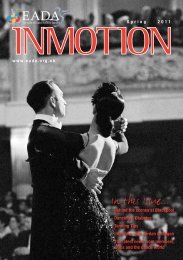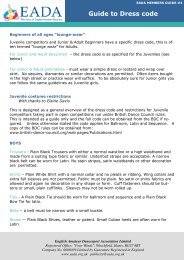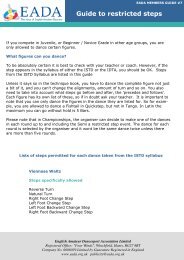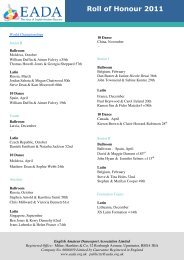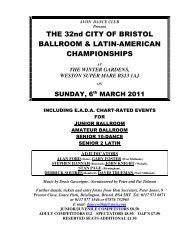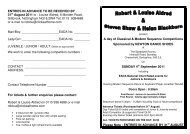A TALE OF TAILSBallroom dancing has changed overthe years – shapes have becomemore exaggerated, dancers areexpected to extend more and it’s allmore athletic. Tailsuits have had toevolve with the style of dancing andhave developed the need to be morestreamlined and performanceorientated.Bespoke continually develop and evolve theirtailsuits to keep up with these changes andtrends. Over the past five years the Pure ClassTailors have been busy introducing many newconcepts to the design and construction ofmodern dancewear. Tailor Andy Brown explainedhow a tailsuit is made and how they havedeveloped their latest design.Each and every suit is cut by hand using themeasurements and notes that have been taken atthe first meeting. Although many of the clothsused are still English woollen cloths, they havechanged considerably from the cloths used 5years ago. The cloths now used are stretchcloths, supplied by traditional Yorkshire Mills orfrom noted cloth merchants Holland & Sherry ofSavile Row. “We have developed some veryparticular cloths for our new suits,” explains Andy,“we have a traditional style woollen cloth with 6%lycra content and a fantastic microfibre cloth witha satin inner face that takes the place of thelining. Both of these have a one way stretchwhich allows the back line to be kept tensionedand clean and means the suit moves much betterwith the dancer. It’s important that a tailsuitmoves with the dancer to show more bodymovement, and not against them which some ofthe older style suits tended to.” The stretch woolsuits are referred to as Feathertouch Tailsuits andthe microfibrePhotos of the cutting process thanks to Andy Brown at Bespoke.The first step in producing a tailsuit is obviouslyto meet with the client and take measurements;around 10 measurements are needed in mostcases, with a few more if the client has specificneeds or physical traits that need specialattention. The tailor will look at their hold andframe and general body shape and note all theindividual characteristics. With more dancersrecognising the benefits of going to the gym,many men have more developed upper-bodiesand this is something new that the tailor has toconsider if they are to produce a well fitting suit.34referred to as Featherweight. Both of these suitshave no linings in the sleeves and trousers andboth of these cloths are lighter than clothspreviously used, with the microfibre being thelightest. “It is important to reduce the amount oflining in stretch suits otherwise the stretch effectwill be lost,” explains Andy, “a lining also adds tothe weight of the suit; without it the cloth canperform much better.”The next stage for a tailsuit takes place in theworkrooms where the sections of cloth that arenow cut are hand basted together. This is the
stage which produces a suit where parts aretacked together by white baste cotton. Thecustomer will try the suit on and the fit ischecked by the tailor, it is at this stage thatchanges to get the perfect finished fit are markedon to the suit. Any changes can be made easily atthis point as the suit is taken apart and re-cut toaccommodate any alterations. It is also at thispoint that the position for any padding in the suitis noted, but in line with the recent changes thepadding is kept to a minimum.Once any adjustments are made the suit is sewntogether. Machines are used in the process to jointogether some of the main sections of the suit,but a lot of the process is still done by hand bythe Bespoke team (consisting of 2 tailors MarkPlant, the business founder, and Andy Brown; 4tailoresses and several dressmakers headed byMelanie Plant co-founder). The linings are allfelled (sewn in) by hand. Bespoke believe intraditional methods, such as using a one piececollar (so that there is no seam on the back orinside edge of the collar). This involves the collarbeing stretched and shaped individually by hand,using a steam iron to stretch the collar to thecorrect shape for each dancer, every collar is thenhand sewn and finished. “As well as doing a lot ofthe work by hand to keep consistently highquality, we believe in using English materials,with as much locally sourced materials aspossible,” explains Andy, “as well as the cloths,all the thread and buttons we use are produced inEngland. If we cannot find a product that is madein England we will either get it made for us or wemake it ourselves.” This year so far Bespoke hasused over 2340 metres of cloth, nearly 4,000buttons have been handmade and used alongwith thousands of meters of cotton and hundredsof meters of lining and canvas.There will then be a collection fitting where anyfinal adjustments are made and the elastics aremarked and sewn in place. The fit and care istalked through with the customer andarrangements to see the dancer on thecompetition floor to check the look whenperforming are made.On average this whole process will take 6-8weeks, but can sometimes be a little quicker if asuit is needed for a specific date. Bespoke can36offer a 3 day service (although there is asurcharge for this service and there are only alimited number of slots available each year).Tailsuits used to have much deeper sleeves andbroader shoulders not to mention additionalweight of the many canvases and sometimesunnecessary padding. Bespoke have now throughhard work and development been able to removea lot of the canvassing and padding along withthe lining, this along with the new lighter clothshas reduced the weight of the suit and stretchmakes them feel even lighter. As methods ofweaving and production of yarn evolves, theproduction and nature of the cloth also evolves.Add to that the changes in the nature of dancingand the need for a competitive edge and there isconstant development of the perfect set of tails.New styles are constantly being researched, thelatest is a new side support, which is built intothe side of the body of the suit and helps tomaintain a clean line. Several top dancers arecurrently testing this and Bespoke will be makingthis and several other developments availablevery soon.Bespoke also produce Latin trousers and outfitsas well as clothing for many other dance stylessuch as American smooth. These can be madeout of the same cloths as the tailsuits or from arange of dance specific fabrics. For Americansmooth suits, Bespoke use a 4 way stretch crepecloth which is very light and moves and performswell and is suited to this dance style. Everythingis all hand cut and made to an individual’s set ofmeasurements. Latin trousers typically take 3-4weeks but it is just as important to get the fit andlook right as on the tailsuits.Dance tailoring differs hugely from regulartailoring and so a comprehensive knowledge ofdancing and its requirements and demands onthe suits is essential, to ensure correct padplacement, and understanding of the silhouetteand the need for a partnership to look balanced.Bespoke brings together a team with knowledgeof regular tailoring and dancing, who care abouthow look fit and feel of the suit, and who nowsupply dancers around the world.With thanks to Mark Plant and Andy Brown at Pure ClassBespoke www.pureclassdancewear.com Pure Class - not justa brand name but a statement of service and qualityCLUB NEWSBEDFORDSHIRE DANCESPORTCLUB, FIRST TO GAINCLUBMARKThe Bedfordshire Dancesport Club has becomethe first dance organisation in the country toreceive Clubmark accreditation. Clubmark is theSport England mark of high quality Junior clubs.To gain this prestigious accreditation, the Clubhas had to look at all its aspects of operations.Staff and Volunteers have all attended varioustraining courses to ensure that all the necessaryoperating standards are understood and met. TheClub gained its Clubmark status through the teamBeds & Luton Sports Partnership because <strong>EADA</strong>does not currently hold a licence.Whilst Clubmark is for Junior clubs we areapplying the same operational standards to theyouth and adult sections of the club ensuring aconsistent quality of service delivery.By Reg Challinor info@dancesportacademy.org.ukhttp://www.dancesportacademy.org.uk/bdc.htmlwww.clubmark.org.ukAVON AMATEURSThe Avon Amateurs have renamed their GayeBiffen day (their annual dance event interspersedwith fund-raising activities), the Gala Charity Dayand diversified the programme to include <strong>EADA</strong>NREs. The club is still supporting Bristol CancerCharities and is proud to have raised over£50,000 in memory of Gaye. The world of dance at your fingertips is monthly, compact sizedand packed with news,reviews, interviewsand features every monthAsk for a FREE introductory copy today!- just call or email and quote <strong>EADA</strong>09(e) free@dancing-times.co.uk (t) 020 7250 30<strong>06</strong> (f) 020 7253 6679Dance Today, 45-47 Clerkenwell Green, London EC1R 0EBwww.dance-today.co.uk



